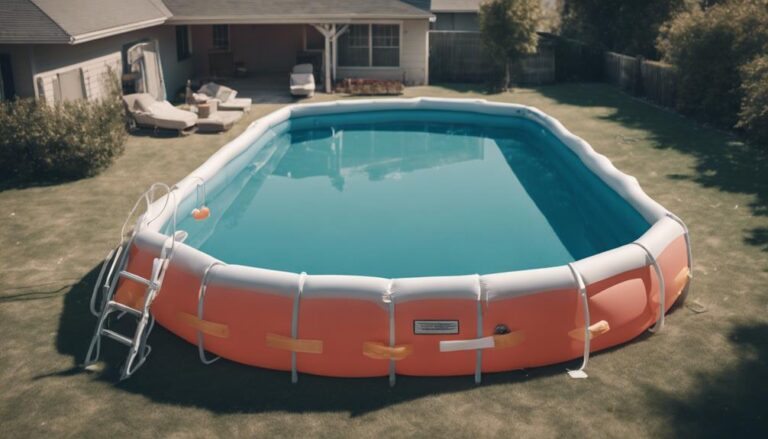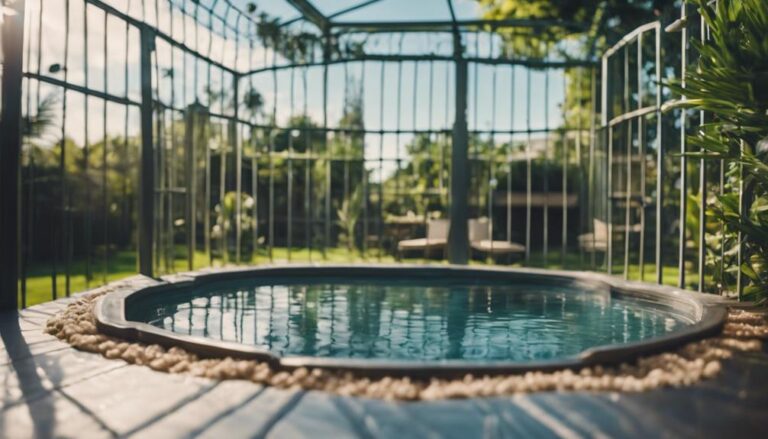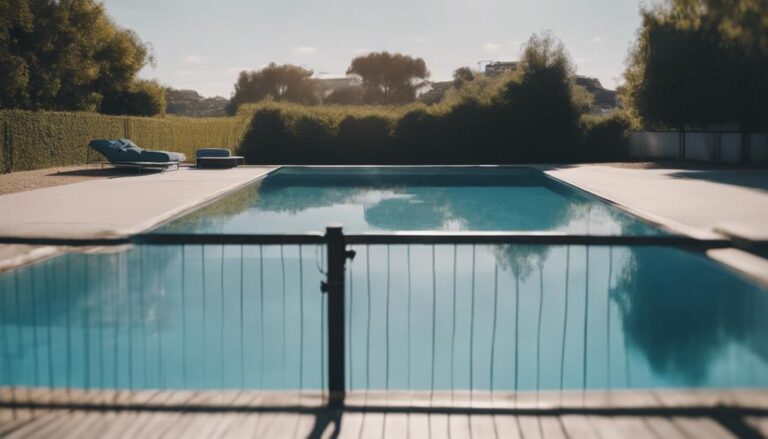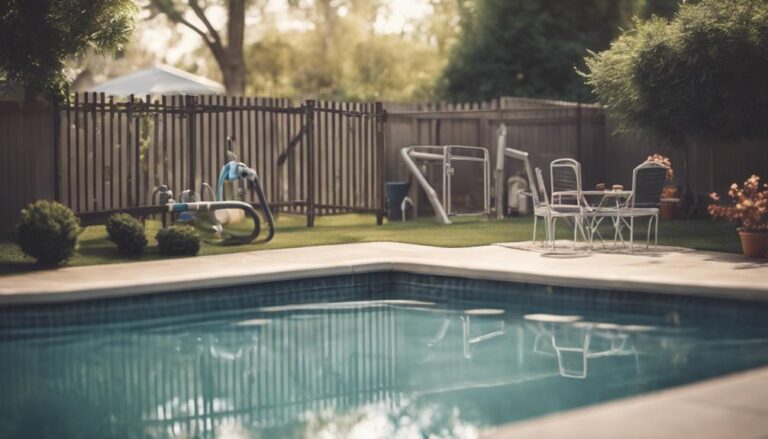Does an Above Ground Pool Need a Fence
Yes, you will need a barrier around your above-ground pool if it is deeper than 300mm. This barrier must be at least 1200mm high, with gaps no wider than 100mm at the bottom.
The pool walls can act as part of the barrier, as long as they are the correct height and non-climbable. It's important to keep any climbable objects at least 900mm away from the pool edge.
Additionally, access points like ladders must have their own compliant fencing and gate. Adhering to these safety standards not only ensures the safety of all users but also complies with local regulations, providing a safe swimming environment for your family.
Further exploration will uncover different ways to effectively secure your pool.
Overview of Fence Requirements
Ensuring your above-ground pool is surrounded by a compliant fence not only improves safety but also offers peace of mind. By adhering to specific fencing requirements, you are making a responsible decision for all who use the pool. For pools deeper than 300mm, a fence that is at least 1200mm high with a gap of no more than 100mm at the bottom is necessary. This guarantees that the barrier is tall enough to deter unauthorised access, particularly by children, and the restricted gap prevents them from squeezing through at the bottom.
Additionally, the walls of your above-ground pool can act as part of the compliant barrier, provided they meet the height and non-climbable criteria. This dual functionality not only conserves space but also blends seamlessly with your pool's design. However, it is vital to ensure that climbable objects near the pool wall are kept at a distance of at least 900mm. Also, the access point, such as a ladder, requires its own compliant fence and gate for enhanced safety. Following these guidelines ensures your above-ground pool remains a secure and enjoyable haven for everyone.
Regulations by Region
When it comes to ensuring the safety of your above-ground pool, it's crucial to be aware of the local ordinances and codes specific to your region. These regulations guide the required height and barrier guidelines to prevent unauthorized access, especially by young children.
Additionally, familiarising yourself with the inspection and compliance procedures can not only help you stay within the law but also promote a safe swimming environment for everyone.
Local Bylaws and Regulations
Before you install your above-ground pool, it's essential to familiarise yourself with the local ordinances and codes. These regulations can vary significantly by region and are crucial for ensuring your pool adheres to safety standards.
Local councils or authorities set out specific requirements for fencing around above-ground pools, emphasising the importance of compliance and safety. In some areas, fencing might be required regardless of the pool's height or depth. However, there could be exemptions or particular guidelines relevant to your situation.
Height and Barrier Guidelines
Ensure the safety of your above-ground pool by following local height and barrier regulations, a crucial step in securing your aquatic sanctuary. In Queensland, for instance, the minimum required height for an above-ground pool fence is 1200mm from the ground. This height is essential to deter unsupervised access. Additionally, the gap at the bottom of any barrier must not exceed 100mm, effectively preventing small access points.
The walls of your pool can act as a part of this safety barrier, as long as they are at least 1200mm tall and are designed to be non-climbable. It is important to keep climbable objects at least 900mm away from the barrier to meet safety regulations. By adhering to these barrier guidelines, you ensure that your above-ground pool is a safe and enjoyable place for everyone.
Inspection and Compliance Procedures
Ensuring your above-ground pool complies with Queensland's strict safety regulations is a critical step in ensuring the well-being of your family. As the owner of the pool, it's your responsibility to make certain that all aspects of your pool, from the barriers to the access points, adhere to Queensland laws. Here is how you can achieve compliance:
- Hire Qualified Inspectors: Only qualified inspectors have the authority and the expertise to accurately determine if your above-ground pools and barriers meet the necessary safety standards.
- Assess Gate Requirements: It's essential that your gates meet Queensland's specific gate requirements to prevent unsupervised access by young children.
- Address Non-Compliance Issues: Should any issues of non-compliance be identified during the inspection, it's imperative that these issues are rectified immediately to ensure that your pool area is both safe and legal.
It is vital to remain informed and prioritise safety by following these crucial steps.
Pool Size and Fence Requirement
Understanding the relationship between the size of your above ground pool and the need for a fence is essential to ensure safety and comply with the law.
If your pool is larger than certain limits, such as being deeper than 300mm, you must install a fence that meets regulations to prevent unauthorised access, particularly by young children.
Let's examine how the dimensions of a pool affect the requirements for fencing, why the legal rules can differ, and why it is important to implement these safety measures for a safe and pleasant swimming area.
Impact of Pool Dimensions
When considering the safety of your garden oasis, it's vital to acknowledge that the size and depth of your above ground pool directly impacts the requirement for a compliant fence.
In Queensland, regulations are explicit:
- Depth of the Pool: If the depth of your pool exceeds 300mm, a compliant pool barrier becomes a mandatory requirement to ensure safety.
- Water Volume Consideration: Pools with a larger volume of water significantly increase the need for pool fencing to prevent accidental falls.
- Role of Dimensions: The overall dimensions, including height and width, are crucial factors in determining the necessity for a compliant fence.
Complying with pool fence regulations isn't merely about adhering to legal demands; it's about fostering a safe and enjoyable environment for all. Ensure your above ground pool adheres to these standards for a carefree summer.
Legal requirements differ
Gain peace of mind by understanding that the legal requirements for fencing around your above-ground pool vary according to its size and depth, ensuring your backyard sanctuary adheres to all safety standards. In Queensland, protecting your family begins with compliance with pool safety laws, which highlight the importance of having a compliant barrier and gate.
| Pool Depth | Fence Necessity |
|---|---|
| Over 300mm | Mandatory |
| Under 300mm | Not Required |
Above-ground pools containing more than 300mm of water or exceeding 2,000L in volume must comply with these regulations. The walls of your pool can serve as a barrier, but it is critical to remember that additional fencing may be required around access points to achieve full safety compliance. Aim to make your pool a safe haven, not merely a place of retreat.
Safety Measures Essential
Understanding the specific requirements for fencing around your above-ground pool is crucial for maintaining compliance with Queensland's safety regulations and plays a critical role in protecting your family from potential hazards.
Here's how you can ensure safety and adherence to regulations:
- Depth Consideration: If your pool has a depth exceeding 300mm, regulations mandate the installation of a fence to mitigate accidents.
- Preventing Unauthorised Access: A secure fence around your pool is imperative for preventing unauthorised access, thus ensuring the safety of children and pets.
- Adherence to Regulations Promotes Safety: Complying with pool fencing laws is vital for enhancing the safety features of your above-ground pool, offering you peace of mind.
This guidance aims to inform and direct you in securing your pool area effectively, in line with legal requirements, thus ensuring a safe environment for all.
Criteria for Inflatable Pools
To ensure the safety and legal compliance of your inflatable pool, it is vital to be aware that any pool with a depth exceeding 300mm or holding more than 2,000L of water must adhere to specific pool safety laws. Understanding these requirements is essential for a worry-free pool experience.
For inflatable pools that meet the depth and volume criteria, registration is obligatory. Registering your pool on the Qld. Pool Register is a crucial step in ensuring that your summer accessory remains a source of enjoyment rather than a liability. This process keeps you informed about the necessary safety standards and regulations, guaranteeing that your pool is a place of fun and not a danger.
Furthermore, having a compliant barrier and gate is essential for securing your inflatable pool. These precautions are in place to prevent unauthorised access, especially by young children, making sure that your backyard retreat is safe for everyone. By following these guidelines, you are not only complying with safety laws but also creating a secure environment for relaxation and entertainment. A properly secured pool is the basis for a stress-free pool ownership experience.
Legal Obligations for Pool Fencing
Ensuring your above-ground pool complies with Queensland's Pool Fencing regulations isn't only a legal requirement but also a critical measure in protecting your family from potential dangers. Compliance isn't merely about fulfilling a requirement; it's about creating a safe environment where enjoyment and relaxation aren't marred by the threat of accidents.
Here's how you can comply and improve safety around your above-ground pool:
- Barrier and Gate Compliance: Ensure your pool barrier and gate adhere to the required safety standards. A compliant fence and self-closing, self-latching gate act as your primary defence against unsupervised access by young children.
- Utilising Pool Walls: If the walls of your pool are sufficiently high, they can form part of the barrier. Nevertheless, the access point, usually where the ladder is, must be securely fenced to deter unauthorised entry.
- Securing Pool Equipment: Fencing around pumps, filters, and associated piping within the non-climbable zone prevents their use as a means to climb over the pool barrier.
Maximum Pool Size Without Fence
Delve into the specifics and learn that any above-ground pool exceeding 2,000L in volume or 300mm in depth requires a compliant fence to ensure safety and legality. Queensland's clear guidelines ensure your pool size not only meets your leisure needs but also aligns with safety standards. Whether you're enjoying a permanent above-ground pool or a portable one, understanding fence requirements is essential.
The pool walls of your above-ground oasis can serve as a compliant barrier, provided they adhere to Queensland's stringent pool fencing requirements. However, it's not just about the pool size or the walls; access points, particularly ladder access, demand careful consideration. A compliant pool fence and gate around the ladder or any pool access point are essential for your safety and compliance with local laws.
Portable pools and spas are also subject to these safety measures. If they meet the criteria based on volume and depth, they too require a registered fence to prevent accidents. Adhering to Queensland's pool safety laws isn't just about avoiding fines; it's about creating a secure environment for everyone to enjoy. So, before you enjoy your above-ground pool, ensure it meets all fence requirements for a worry-free experience.
Minimum Distance Guidelines for Fences
When installing safety barriers for your above-ground pool in Queensland, adhering to minimum fence distance guidelines is essential for both compliance and the safety of all pool users. These regulations aim to make your pool area both compliant and a secure environment where family and friends can enjoy peace of mind.
For clarity, here are the essential guidelines to follow:
- Pool Walls as Barriers: For above-ground pools, the pool walls can act as a compliant barrier if they meet the required height criteria. These walls must be at least 1200mm in height and constructed to be non-climbable, preventing easy access for young children.
- Maximum Allowable Gap: The space at the bottom of any pool barrier, including those for above-ground pools, shouldn't exceed 100mm. This measure is to stop small children from crawling underneath and gaining unsupervised access to the pool area.
- Distance from Climbable Objects: Position all climbable objects at least 900mm away from the pool barrier. This rule applies to furniture, trees, and other structures that could facilitate climbing over the barrier, ensuring your pool area remains a safe, compliant, and enjoyable space for everyone.
DIY Pool Fence Installation
After understanding the guidelines for minimum fence distance, it's time to consider how you can confidently install a pool fence around your above-ground pool, prioritising safety and compliance. Adopting a DIY approach allows you to secure your pools personally while ensuring you meet the essential QLD pool fencing regulations. Begin with the fence height, ensuring it's at least 1200mm above ground level to comply with standards.
Your DIY installation journey should focus on installing a gate equipped with self-closing and self-latching mechanisms. This crucial feature prevents unintentional access by children, significantly improving pool safety. Additionally, vigilance against climbable objects near the fence line is vital. Maintain a 900mm clearance to eliminate any potential risks that could compromise the barrier's effectiveness.
Lastly, don't overlook the importance of non-climbable barriers around the ladder access point. This additional layer of protection ensures that the entry and exit points to your above-ground pool are secured against unauthorised access. By adhering to these guidelines, your DIY pool fence installation won't only comply with standards but also provide a safe, enjoyable environment for all.
Ensuring Pool Safety Compliance
Ensuring your above-ground pool adheres to Queensland's safety regulations is a crucial step in creating a secure environment in your garden for family and friends. Compliance isn't just about following the rules; it's about protecting your loved ones.
Here is how you can comply with Queensland's pool safety requirements:
- Barrier and Gate Compliance: It is essential to surround your above-ground pool with a compliant barrier and gate to prevent young children from accessing the pool. This includes ensuring the pool walls meet Queensland Pool Fencing requirements if they are used as part of the barrier.
- Secure Pool Access: A compliant fence and gate should enclose the ladder or any other access points to the pool. This step is crucial for controlling access and ensuring safety.
- Maintain a Non-Climbable Zone: Place all climbable objects, such as furniture, plants, or pool equipment, outside the 1200mm non-climbable zone. This also involves fencing off pumps, filters, and associated piping within this area to discourage their use as a means to climb over the fence.
Frequently Asked Questions
Is a fence required around an above-ground pool?
Yes, you'll need a fence around your above-ground pool if it's deeper than 300mm. It's not just a safety measure—it's a requirement to keep young children safe. Make sure it meets Queensland's regulations.
Do I need a pool fence around an above-ground pool?
Yes, you need a pool fence around your above-ground pool if it's over 300mm deep. It ensures safety and complies with regulations, keeping children safe while they enjoy splashing around.
Is it illegal to not have a fence around a pool in Australia?
Yes, in Australia, it is against the law not to have a fence around your pool, including above-ground pools. It is essential for safety to prevent young children from accessing the pool unsupervised and to avoid being fined for not complying with the regulations.
What kind of fence do you need for an above-ground pool?
You will need a compliant fence for your above-ground pool that meets specific height and non-climbable standards. Make sure it surrounds the ladder area as well, keeping safety and regulations in mind for a worry-free summer!






